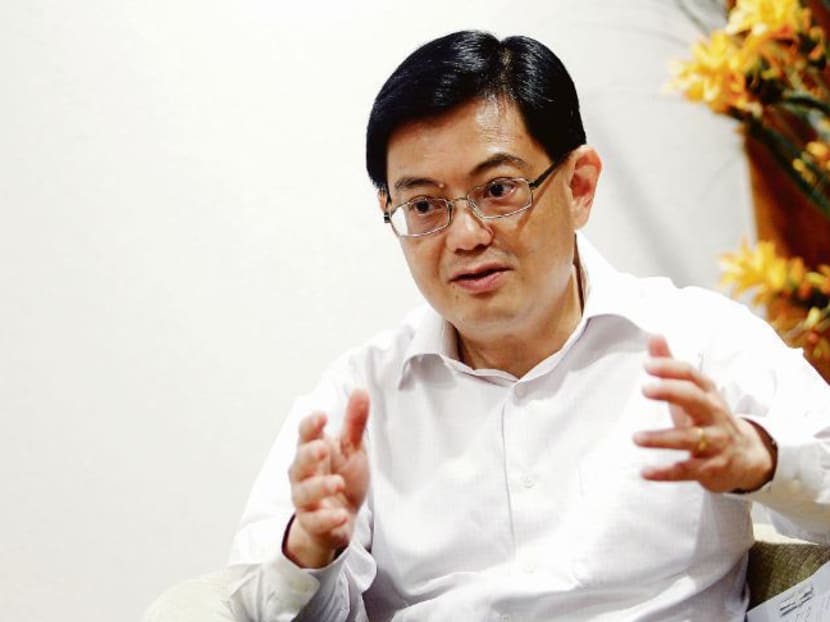Growth, innovation and resilience on the cards for Asean finance meetings next week
SINGAPORE — Sustaining growth, particularly in infrastructure development, boosting resilience against unexpected events, and fostering innovation are the three key areas that South-east Asian finance ministers and senior banking officers will be focusing on during their meetings next week, said Finance Minister Heng Swee Keat.

Finance Minister Heng Swee Keat says sustaining growth, boosting resilience against unexpected events, and fostering innovation are the three key areas that Asean finance ministers and senior banking officers will be focusing on during their meetings next week. TODAY file picture
SINGAPORE — Sustaining growth, particularly in infrastructure development, boosting resilience against unexpected events, and fostering innovation are the three key areas that South-east Asian finance ministers and senior banking officers will be focusing on during their meetings next week, said Finance Minister Heng Swee Keat.
In a media briefing ahead of the 4th Association of South-east Asian Nations (Asean) Finance Ministers’ and Central Bank Governors’ meetings in Singapore from April 3 to 6, Mr Heng said although infrastructure development is a key priority for all 10 Asean members, infrastructure financing gap remains “substantial.”
Singapore is the Asean chair this year.
Citing figures from the Asian Development Bank (ADB), Mr Heng said the total infrastructure bill for the region is estimated at US$2.8 trillion (S$3.67 trillion) between 2016 and 2030, or about US$184 billion per year.
Climate-adjusted forecasts are even higher at US$3.1 trillion, or US$210 billion per year.
“It is not possible for governments to fund these needs alone. We have to look at better mobilisation of private capital. To do so, we need better ways to match demand for infrastructure to the supply of funds,” he said.
“We need to create greater awareness of infrastructure projects within Asean, as well as to better understand the potential investors’ needs.”
As such, he said Asean Finance Ministers will participate in a roundtable discussion with potential investors.
“(We) hope this helps promote great capital participation in our regional infrastructure projects,” said Mr Heng.
With global investors increasingly looking at sustainability considerations in their investments, he said Asean will also build on its green bonds standards that was launched last year to encourage more green bonds issuances as well as other sustainable finance instruments.
Touching on the second pillar of the meetings, which is aimed at boosting resilience against unexpected events and deliberate attacks, Mr Heng noted that several Asean member states remain highly exposed to natural disasters and yet, disaster financing within the region has not kept pace with economic growth, resulting in widening protection gap.
As such, the meetings will also focus on enhancing disaster resilience and support initiatives, and this includes improving data availability on Asean’s economic exposure to natural catastrophes.
Another emerging risk that the minister flagged is cybersecurity.
Mr Heng noted that there is room for Asean regulators to enhance collaboration to increase cyber resilience in the financial sector.
“We’ll be discussing how we can improve our cybersecurity intelligence and the exchange of information on this — for example, whether it is exchanging information on the attacks that have taken place, or intelligence that attacks may be impending, and how we could work together to improve our cybersecurity across the region,” he said.
“That sort of information sharing will be valuable across the whole of Asean ... so that everyone can learn from it.”
He also said they will continue to boost regional financial stability by strengthening existing institutions and initiatives like the Chiang Mai Initiative Multilateralisation and the Asean+3 Macroeconomic Research Office (AMRO).
Lastly, the minister said Asean is looking to support digital innovations like fintech which can promote financial inclusion for underserved and unbanked segments of society.
It is also planning to expand capacity building in new emerging areas such as big data analytics to equip Asean citizens so that they have the know-how and confidence to ride the wave of opportunities associated with innovation.
Citing an example of a link-up of Singapore and Thailand’s real-time retail payment systems, Mr Heng said such strong potential in pioneering regional linkages for faster payment system can boost Asean’s economic integration and e-commerce.
The initiative to link Singapore’s PayNow system to the Thai equivalent, known as PromptPay, was announced at the end of last year.
Touching on the simmering tensions between two of the world’s largest economies — the United States and China, the minister said Singapore has not seen any “major impact” from it, although the Republic is closely monitoring the “warning signs”.
“We have to work very hard to ensure that this does not escalate because at the end of the day, a trade war would damage all economies,” he said.
“At this stage, we are not seeing major impact yet. We had better build a consensus for free trade so that the situation does not deteriorate. In fact we hope that we can reverse the mood at the moment.”
Fears of a trade war between Washington and Beijing escalated after the Trump administration last week slapped up to US$60 billion in tariffs on some Chinese imports, prompting a warning from Beijing that it could retaliate with duties of up to US$3 billion of US imports.
In the Asean region though, Mr Heng said he was glad that there is “continuous strong support” among member states for free trade and integration.
The grouping will continue to sustain the momentum for trade liberalisation, with the move towards the Asean Economic Community — a blueprint to integrate South-east Asia’s diverse economies into a single market — as well as negotiations for the Regional Comprehensive Economic Partnership, which involves Asean, Australia, China, India, Japan, South Korea and New Zealand.






